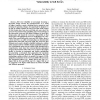Free Online Productivity Tools
i2Speak
i2Symbol
i2OCR
iTex2Img
iWeb2Print
iWeb2Shot
i2Type
iPdf2Split
iPdf2Merge
i2Bopomofo
i2Arabic
i2Style
i2Image
i2PDF
iLatex2Rtf
Sci2ools
108
click to vote
MICRO
2010
IEEE
2010
IEEE
AVF Stressmark: Towards an Automated Methodology for Bounding the Worst-Case Vulnerability to Soft Errors
Soft error reliability is increasingly becoming a first-order design concern for microprocessors, as a result of higher transistor counts, shrinking device geometries and lowering of operating voltages. It is important for designers to be able to validate whether the Soft Error Rate (SER) targets of their design have been met, and help end users select the processor best suited to their reliability goals. The knowledge of the observable worst-case SER allows designers to select their design point, and bound the worst-case vulnerability at that design point. We highlight the lack of a methodology for evaluation of the overall observable worst-case SER. Hence, there is a clear need for a so called stressmark that can demonstrably approach the observable worst-case SER. The worst-case thus obtained can be used to identify reliability bottlenecks, validate safety margins used for reliability design and identify inadequacies in benchmark suites used to evaluate SER. Starting from a comprehe...
| Added | 14 Feb 2011 |
| Updated | 14 Feb 2011 |
| Type | Journal |
| Year | 2010 |
| Where | MICRO |
| Authors | Arun A. Nair, Lizy Kurian John, Lieven Eeckhout |
Comments (0)

